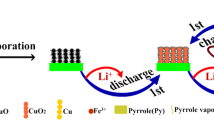Abstract
We report the synthesis of CuO cubes with well-defined size and shape by thermal treatments of Cu2O cubes. Polydopamine (PDA) is introduced to modify the CuO cubes by the in-situ polymerization of the dopamine precursor. The initial specific capacity of the lithium-ion batteries using the CuO cubes as anodes increases about 10 times at a 0.5 C rate as a result of the modification of PDA. The overall specific capacity for 100 cycles also increases effectively due to the introduction of PDA. So PDA as surface modifying agent significantly improves the electrochemical performance of the CuO anodes.
Similar content being viewed by others
References
Cheng X L, Jiang J S, Jiang D M, et al. Synthesis of rhombic dodecahedral Fe3O4 nanocrystals with exposed high-energy {110} facets and their peroxidase-like activity and lithium storage properties. J Phys Chem C, 2014, 118: 12588–12598
Lan D N, Chen Y Y, Chen P, et al. Mesoporous CoO nanocubes @ continuous 3D porous carbon skeleton of rose-based electrode for high-performance supercapacitor. ACS Appl Mater Inter, 2014, 6: 11839–11845
Lv P P, Zhao H L, Zeng Z P, et al. Self-assembled three-dimensional hierarchical NiO nano/microspheres as high-performance anode material for lithium ion batteries. Appl Surf Sci, 2015, 329: 301–305
Wang C D, Xu J L, Ma R G, et al. Facile synthesis of CuO nanoneedle electrodes for high-performance lithium-ion batteries. Mater Chem Phys, 2014, 148: 411–415
Chen Y J, Zhu C L, Xue X Y, et al. High capacity and excellent cycling stability of single-walled carbon nanotube/SnO2 coreshell structures as Li-insertion materials. Appl Phys Lett, 2008, 92: 223101–223103
Xiang J Y, Tu J P, Zhang L, et al. Self-assembled synthesis of hierarchical nanostructured CuO with various morphologies and their application as anodes for lithium ion batteries. J Power Source, 2010, 195: 313–319
Wang Q, Zhang C Y, Shan W F, et al. Uniformly loading NiO nanowalls on graphene and their extremely high capacity and cyclability as anodes of lithium-ion batteries. Mater Lett, 2014, 118: 66–68
Wang Z Y, Madhavi S, Lou X W. Ultralong α-MoO3 nanobelts: synthesis and effect of binder choice on their Lithium storage properties. J Phys Chem C, 2012, 116: 12508–12513
Chen Y J, Di X P, Ma C, et al. Graphene–MoO2 hierarchical nanoarchitectures: In situ reduction synthesis and high rate cycling performance as lithium-ion battery anodes. RSC Adv, 2013, 3: 17659–17663
Yuan Y, Pei Y B, Fang J, et al. Sponge-like mesoporous CuO ribbon clusters as high-performance anode material for lithium-ion batteries. Mater Lett, 2013, 91: 279–282
Chen K F, Xue D F. Chemical reaction and crystallization-controllable synthesis of electrochemical electrode materials for energy storage (in Chinese). Sci Sin Tech, 2015, 45: 36–49
Yin Z G, Fan W B, Ding Y H, et al. Shell structure control of PPy-modified CuO composite nanoleaves for Lithium batteries with improved cyclic performance. ACS Sust Chem Eng, 2015, 3: 507–517
Holze R, Wu Y P. New carbon materials for electrochemical storage. J Solid State Eletrochem, 2003, 8: 66–72
Zheng S F, Hu J S, Zhong L S, et al. Introducing dual functional CNT networks into CuO nanomicrospheres toward superior electrode materials for Lithium-ion batteries. Chem Mater, 2008, 20: 3617–3622
Wang B, Wu X L, Shu C Y, et al. Synthesis of CuO/graphene nanocomposite as a high-performance anode material for lithium-ion batteries. J Mater Chem, 2010, 20: 10661–10664
Wang C D, Zhang Q M, Wu Q H, et al. Facile synthesis of laminate-structured graphene sheet–Fe3O4 nanocomposites with superior high reversible specific capacity and cyclic stability for lithium-ion batteries. RSC Adv, 2012, 2: 10680–10688
Chen K F, Xue D F, Komarneni S. Beyond theoretical capacity in Cu-based integrated anode: insight into the structural evolution of CuO. J Power Source, 2015, 275: 136–143
Chen K F, Xue D F. A chemical reaction controlled mechanochemical route to construction of CuO nanoribbons for high performance lithium-ion batteries. Phys Chem Chem Phys, 2013, 15: 19708–19714
Chen K F, Xue D F. Ex-situ identification of the Cu+ long-range diffusion path of a Cu-based anode for lithium-ion batteries. Phys Chem Chem Phys, 2014, 16: 11168–11172
Chen K F, Song S Y, Xue D F. Faceted Cu2O structures with enhanced lithium-ion battery anode performance. CrystEngComm, 2015, 17: 2110–2117
Chen K F, Song S Y, Xue D F. Chemical reaction controlled synthesis of Cu2O hollow octahedral and core-shell structures. CrystEng Comm, 2013, 15: 10028–10033
Chen K F, Xue D F. Room temperature chemical transformation route to CuO nanowires toward high performance electrode materials. J Phys Chem C, 2013, 117: 22576–22583
Liu Q, Wang N Y, Caro J, et al. Bio-inspired polydopamine: a versatile and powerful platform for covalent synthesis of molecular sieve membranes. J Am Chem Soc, 2013, 135: 17679–17682
Wang L, Wang D, Zhang F X, et al. Interface chemistry guided long-cycle-life Li–S battery. Nano Lett, 2013, 13: 4206–4211
Jiang D H, Zhou W, Zhong X H, et al. Distinguishing localized surface Plasmon resonance and schottky junction of Au–Cu2O composites by their molecular spacer dependence. ACS Appl Mater Inter, 2014, 6: 10958–10962
Author information
Authors and Affiliations
Corresponding authors
Electronic supplementary material
Rights and permissions
About this article
Cite this article
Hao, L., Wu, L., Jia, Z. et al. Effects of polydopamine modification on self-grown CuO cube anodes in lithium-ion batteries. Sci. China Technol. Sci. 59, 667–672 (2016). https://doi.org/10.1007/s11431-016-6011-8
Received:
Accepted:
Published:
Issue Date:
DOI: https://doi.org/10.1007/s11431-016-6011-8




